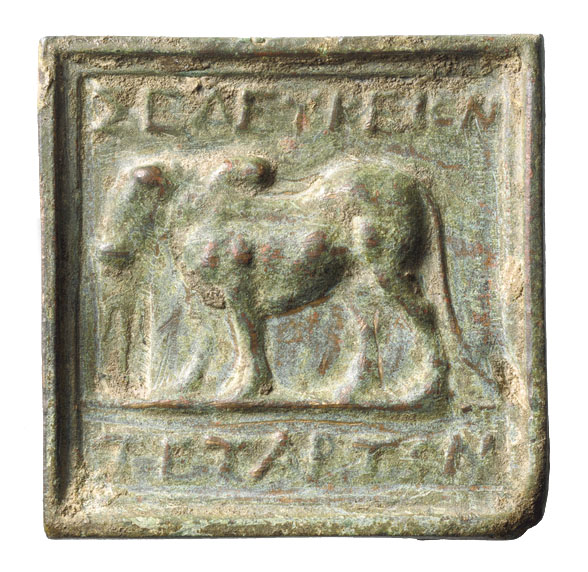
-
Copyright credit: J. Paul Getty Museum

ARCHAEOLOGICAL DESCRIPTION OF THE WEIGHT
Authority
Mint
Seleucia Pieria
Denomination
1/4 Mina
Material
Copper alloy (bronze or brass)
Manufacture
Cast
Shape
Square
Length
7.20 cm
Width
7.20 cm
Height
0.50 cm
Metrology
| Mass (g) | Mass (grain) | Date of measurement | Reference | fragmented | cleaned | reference weight |
|---|---|---|---|---|---|---|
| 128.00 | - | - | True and Hamma 1994 | No | No | Yes |
Iconography
| Symbol | Technique | Direction | Position | Number | Synecdoche |
|---|---|---|---|---|---|
| Zebu | Relief | LEFT | Walking | ||
| Anchor | Stamped / Countermarked / Struck | ||||
| Lattice pattern | Relief |
Wear
Corrosion
Handle
No
Suspension hole
No
Recarved mould
No
Recarved weight
No
Intentionally destroyed
No
Archaeological description
True and Hamma 1994: Hellenistic, first half of second century B.C. Bronze; H: 7.2 cm; w: 7.2 cm; Depth: 0.5 cm; Weight: 128 g (Tetarton = Quarter Mina of Seleucia Pieriae). Condition: Intact except for battered lower right corner. Provenance: Found near Adana (together with cat. no. 94). The weight is a square plaque. Its obverse has a plain molded frame and shows, in medium-low relief, a walking zebu seen in profile facing the viewer’s left. The piece is inscribed in relief letters. Above the figure ΣΕΛΕΥΚΕΙΟΝ (of the inhabitants of Seleucia). Below: ΤΕΤΑΡΤΟΝ (tetarton). The reverse has a very regular net pattern within a narrow raised border. The zebu, a humped Indian breed of bull known as a “Brahman” in the West today, had much the same appearance as the modern variety, and, like the elephant, was an appropriate symbol for an eastward-looking city founded by one of Alexander’s successors. A closely related lead tetarton of Antioch in Syria, with a zebu walking toward the right and the same net pattern, is in the Bibliothèque Nationale in Paris (see Seyrig; Babelon/Blanchet; Michon).
Getty Museum: Designed to be used with a simple pan balance, this weight bears an image of a zebu, a type of humped Indian breed, known today as a Brahma bull. The weight comes from Seleucia Pieria the port city of Antioch, the capital of the Seleucid Empire. The inscription "Seleukeion" above the bull gives its place of origin and indicates that this was an official weight, used as a standard against which commercial weights could be checked. The lower inscription gives the weight of the piece as a tetarton, which was a quarter of a mina, the basic unit of weight used in the Seleucid Empire at this time. A net pattern with a narrow raised border covers the back of the weight. Founded by one of Alexander the Great's generals, the Seleucid dynasty often used symbols alluding to Alexander's huge empire as a visual reminder of their origins and right to rule. Images such as the zebu and the elephant represented connections to India, the farthest reach of Alexander's empire. They were used on items produced by the Seleucid government, like coins and official weights.
Getty Museum: Designed to be used with a simple pan balance, this weight bears an image of a zebu, a type of humped Indian breed, known today as a Brahma bull. The weight comes from Seleucia Pieria the port city of Antioch, the capital of the Seleucid Empire. The inscription "Seleukeion" above the bull gives its place of origin and indicates that this was an official weight, used as a standard against which commercial weights could be checked. The lower inscription gives the weight of the piece as a tetarton, which was a quarter of a mina, the basic unit of weight used in the Seleucid Empire at this time. A net pattern with a narrow raised border covers the back of the weight. Founded by one of Alexander the Great's generals, the Seleucid dynasty often used symbols alluding to Alexander's huge empire as a visual reminder of their origins and right to rule. Images such as the zebu and the elephant represented connections to India, the farthest reach of Alexander's empire. They were used on items produced by the Seleucid government, like coins and official weights.
Autopsy
No
INSCRIPTION
| Language | Technique | Legend type |
|---|---|---|
| Greek | Relief | Denomination, Mint |
Fac simile
Edition
Σελεύκειον | τέταρτον.
Monogram
ARCHAEOLOGICAL CONTEXT
Findspot (region)
Türkiye: Adana
Findspot (site)
Adana / Antiochia ad Sarum
context
True and Hamma 1994: Found near Adana (together with cat. no. 94)
CIRCUMSTANCES OF ACQUISITION
Region
City
Date of first acquisition
Dec. 31, 1988
circumstances
Gift of Barbara and Lawrence Fleischman (New York, 1925 - New York, 1997) to the J. Paul Getty Museum in 1996. Sold to Barbara and Lawrence Fleischman in 1988, Fritz Bürki & Son (Zurich, Switzerland).
DATING OF THE WEIGHT
Curatorial Section
GREEK
Time frame
FROM
-250
TO
-100
Comments on Chronology
Getty Museum: First half of 2nd century B.C. According to Seyrig 1946–48, p. 45–46: 301–187/6 BCE; Gatier 1994: mid-2nd c. BCE?
COLLECTION HISTORY
Collection
| Name | Date of acquisition | Inventory number |
|---|---|---|
| Fleischman Collection | Dec. 31, 1988 | F166 |
| Getty Museum – Getty Villa (Malibu) | Dec. 31, 1996 | 96.AC.143 |
Bibliography
| Reference | Page/Column | Reference (number) | Plate / Figure | Comment |
|---|---|---|---|---|
| True and Hamma 1994 | 202 | 95 | fig. 95 | None |
| Bodel and Tracy 1997 | 10 | (non vidi) | ||
| Getty Museum 1997–98 | 65 | |||
| Tekin 2025a | None | None | fig. 21 | None |
VARIA
Additional comment
Permalink